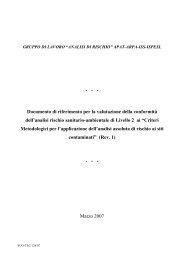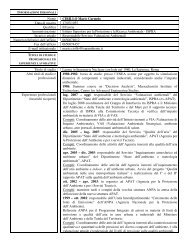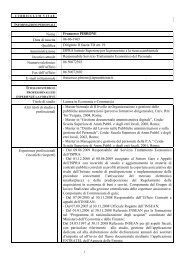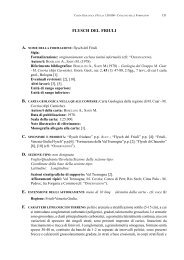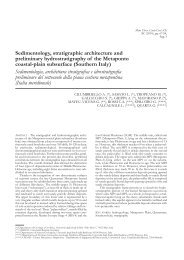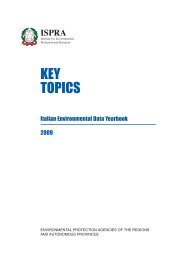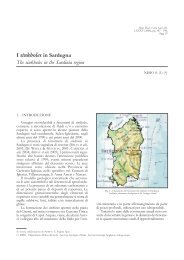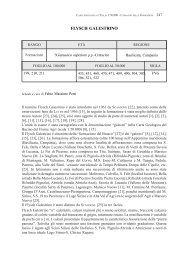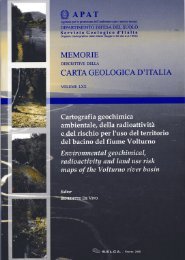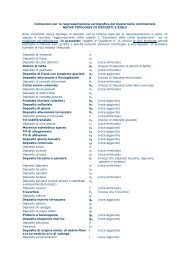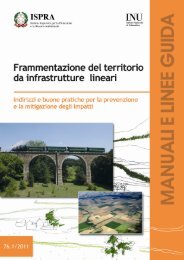Guidebook - Ispra
Guidebook - Ispra
Guidebook - Ispra
You also want an ePaper? Increase the reach of your titles
YUMPU automatically turns print PDFs into web optimized ePapers that Google loves.
Stop 5.15:<br />
Dealul Mare. Metaconglomerates of the<br />
Păiușeni Series.<br />
The road crosses the divide between the hydrographic<br />
basins of the Black and the White Criș; at this point,<br />
the metaconglomerates of the Poiana Nappe are exposed.<br />
Measurements on their pebbles indicated an extensional<br />
strain for the whole Poiana Nappe, in one point<br />
only the strain is a flattening one.<br />
The road continues across the Miocene post-tectonic<br />
basin.<br />
Between Brad and Vălișoara upriver the Luncoiu valley<br />
on both sides of the main road, Mesozoic islandarc<br />
(U3-K1) andesitic-basaltic volcanics (basalts and<br />
andesites are associated with gabbros, but also with<br />
dacites, rhyolites as well as with orthophyres and oligophyres<br />
as pyroclastics) as well as the Miocene molasse<br />
deposits represented mainly by the red “Almasu<br />
Mare gravels” (Badenian) are exposed; the latter belong<br />
to the Brad-Săcărâmb sedimentary basin where<br />
the Neogene volcanics are widely developed.<br />
In the Dealul Mare col the characteristic landscape of<br />
volcanic peaks is to be seen.<br />
At Vălișoara, the Upper Jurassic andesitic and basaltic<br />
flows and pyroclastics are overlain by Upper<br />
Jurassic calcareous olistoliths and by Aptian Wildflysch<br />
formations.<br />
Downstream the Vălișoara valley, after the island-arc<br />
GEOLOGICAL STRUCTURE OF THE ROMANIAN CARPATHIANS<br />
Figure 9 - Simplifi ed map of Vâlcan-Parâng Mts.<br />
(T.Berza and V.Iancu, 1994).<br />
complex beginning at Săliștioara the road crosses<br />
ophiolitic rocks belonging to the Techerău Nappe,<br />
porphyritic basaltic lavas with augite phenocrysts,<br />
andesites with hornblende as well as porphyroclastics<br />
(aglomerates and tuffs) are conspicuous (Savu et al.,<br />
1986).<br />
Some “Klippen” of Upper Jurassic and Urgonian<br />
limestones can be noticed.<br />
Succeeding the ophiolitic complex, after an EW striking<br />
fault, the Căbești Formation (Barremian-Lower<br />
Aptian) is exposed, namely black gritty shales with<br />
intercalations of siliceous sandstones; they belong to a<br />
particular unit, the Căbești Unit (Bleahu et al., 1981).<br />
Stop 5.16:<br />
Fornădia. Mesocretaceous unconformity.<br />
A small hill marks the unconformity between the<br />
Căbești Formation, represented by strongly disturbed<br />
quartzitic sandstones and clayey shales and the gently<br />
dipping Fornădia Beds (Vraconian-Cenomanian).<br />
The latter start with quartzitic micro-conglomerates<br />
and calclithites. The coarse bedding becomes thinner<br />
(15-50 cm) towards the top of the formation. In thin<br />
slides Paraphillum primaevum is frequent.<br />
After another EW oriented fault, the road reaches<br />
the area of the Bejan Unit, in which the Bejan Formation<br />
is characteristic. This formation consists of<br />
B12<br />
35 - B12<br />
Volume n° 1 - from PR01 to B15



